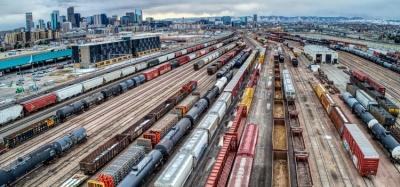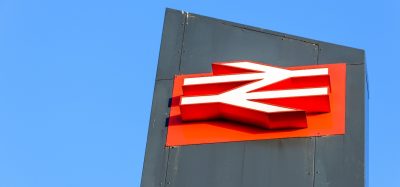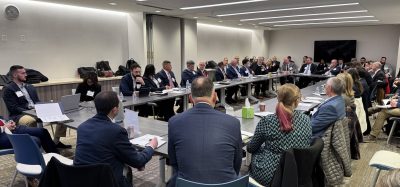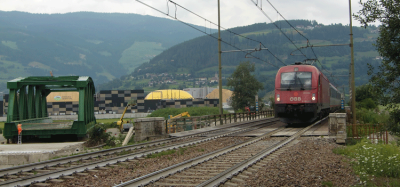ProRail’s management of tracks and turnouts
Posted: 30 July 2007 | | No comments yet
ProRail manages an installed base which has an estimated replacement value of more than €30 billion. Tracks and turnouts are a significant part of the pie, amounting to more than €8 billion. Moreover, they consume more than 50% of total maintenance costs and 75% of renewal costs due to their usage-based, relatively rapid deterioration pattern […]
ProRail manages an installed base which has an estimated replacement value of more than €30 billion. Tracks and turnouts are a significant part of the pie, amounting to more than €8 billion. Moreover, they consume more than 50% of total maintenance costs and 75% of renewal costs due to their usage-based, relatively rapid deterioration pattern and high cost of installation. Last but not least, track and turnouts, and especially high-speed turnouts are important because they are sources of failure and traffic disruption. This is why ProRail develops policy plans for track product and maintenance management.
This article briefly drafts ProRail’s product management and maintenance policy, which aims to deliver optimum performance levels of tracks and turnouts. The policy is a formal working document within ProRail, which sets out which track products, standards and maintenance strategies deliver best value for money1.
Infrastructure management in the Netherlands
ProRail is appointed by the Dutch Government to manage the rail infrastructure in the Netherlands under a concession until 2015. This includes construction and maintenance management, transportation capacity planning and allocation, and daily traffic control. Since 1997, first, Netherlands Railways and later ProRail, as separated Infrastructure Manager, outsources the execution of so-called process maintenance activities to three contractors, Strukton, Volker Stevin and BAM, whereas major renewals are publicly tendered according to European competition regulation. Contracts for processes such as train-based inspections, grinding and ICT systems maintenance have been awarded to specialised companies. ProRail also takes care of new construction, extensions and upgrading works, such as the recently opened Betuweroute and track quadrupling of the Amsterdam-Utrecht corridor.
It is ProRail’s responsibility that the individual contracts and projects add to specified performance targets for the network, agreed upon by the Ministry of Transport and ProRail. ProRail is meeting these standards, with performance improving steadily over recent years. An availability level of over 99% was achieved in 2006. ProRail steers by means of:
- Specifying basic quality levels for different life cycle phases, in the mentioned contracts
- Monitoring the quality of the infrastructure and the output of individually delivered works and maintenance processes
- Acting upon deviations in output, through contract management, technical regulations and a planning cycle for (larger) maintenance and renewal
Process maintenance standards are, as much as possible, defined in terms of output quality. This provides more freedom to contractors to organise their work processes optimally. If safety or durability (life cycle cost) demands require this, or relations between input and output are not well known or measurable, quality is assured through prescribed frequencies of maintenance tasks. Last May, the so-called ‘Gelre pilot’, the first public tendering of a process maintenance contract, started. Gelre is one of 38 contract areas.
ProRail still needs a strong knowledge base in order to manage this type of contract, and to optimise costs and performance over the life cycle of assets, through contract regulations. This is taken care of by a centralised Technical Department (named InfraSystems) as well as technical specialists in the four regions. Several tools are used to lay down knowledge on maintenance and co-ordinate maintenance policy with other processes such as planning of renewals. Examples are Maintenance Documents based on Failure Mode Effects Analysis (FMECA), a ‘Knowledge Bank’ of Life-Cycle Costing (LCC) analyses, and ‘Yardsticks’ that determine the residual life of the assets2.
The Dutch track system
The standard track system consists of 54E1 rails on concrete monoblock sleepers and a ballast bed of 30cm. The same type of rails on creosoted timber sleepers is still installed on many lines, but its (re-)use has been banned due to environmental policy. Duoblock concrete sleepers have also been applied widely and are still performing well on main lines. NP46, an older, less heavy rail type, is still in service on lines with lower traffic loads.
More than 80% of track is now continuously welded rails (CWR), which is standard technology for all main lines. The percentage will increase, thanks to a dedicated investment budget for noise reductions at railway yards. The main driver are increasingly tight requirements on noise emissions.
Turnouts are relatively complex, failure prone systems, which is why standardisation is being strived for. Standard angles for turnouts are 1:9, 1:12, 1:15, 1:18.5 and 1:34.7. Often, special engineering of the concrete turnouts is required on railway yards due to the limited space available, once they replace older types of turnouts (e.g. 1:8, or double-slip turnouts). All turnouts in the central traffic control area are served by switch heating systems, mainly gas fuelled. Electricity and earth warmth are other sources, increasingly being used. Central and local monitoring is used for the operation of switch heating.
Guidelines for track construction, maintenance and renewal
A number of starting points on how to design and maintain the tracks effectively and efficiently guide product developments and the policy for maintenance and renewal. Life cycle costs and effects on RAMSHE13 are the leading criteria for overall strategies and individual measures and projects at ProRail. High safety and reliability and low life cycle costs should be delivered, while meeting other business objectives as well. A standard set of LCC based policy rules is available for optimising between maintenance and renewal3.
The starting points are listed below and are based on general maintenance management theory. They are listed from more to less effective, depending on the phase of the life cycle in which they can be applied – the earlier in the life of an asset, the larger their influence on performance:
- Removing unproductive assets
A basic starting point is that turnouts and track proposed for renewal should always be reviewed on potential rationalisation. This can result in quick wins for maintenance, but needs to be traded off in a total picture of cost and benefits for traffic control (routing possibilities) and infrastructure management. - Standardisation and development of supplier markets
Product specifications are reviewed and revised in order to improve market entry for more suppliers. Nevertheless, standardisation remains a crucial need, not least for failure-critical components. It is advantageous for installation costs, spare parts management, training of personnel and quick repair and replacement. ProRail supports actively the development of European technical standards, in many working groups, as this serves the objectives of both standardisation and a better functioning supplier market. - Establishing high inherent quality
A basic rule is that money should be spent on robustness of assets, not on ‘luxury items’. Heavy utilisation needs robust infrastructure. On the other hand, light track designs, with sleeper distance of 75cm and ballast thickness of 20cm, are allowed on UIC Class 6 tracks. ProRail has had several examples on its network where projects delivered hard to maintain, failure-prone assets. The quality management system has been enhanced in order to only allow certified, well-tested products in the infrastructure, without blocking good, innovative ideas. - Preventing deterioration (causes)
Unneeded loads and frictions on the track should be avoided. It can be stated that ProRail’s tracks are subjected to a ‘Stress Regime’ according to the definition of IHHA, with high frictions and loads from the operation resulting in cracks and premature loss of rail life4. Moving more towards a so-called ‘Wear Regime’, where rail life is determined by wear, will therefore be advantageous for the life cycle costs. Rail profiles have therefore been modified, while grinding provides artificial wear, whereas optimising combinations of wheel/rail profiles is still largely unexplored and difficult to arrange in the European interoperable system. - Removing damage in an early stage
Once damage occurs, it will accelerate degeneration of track. This should be avoided through grinding, timely spot tamping, removal of short wave irregularities, and so on. - Applying life-extending measures and clustering works
Once the end of track life is in sight, it is often cost-effective to extend life for some time through large-scale repair of fastenings. The strategy prescribes that benefits are traded off against costs. Decisions vary, depending on the local situation. Often scale and scope advantages can be realised once individual assets are combined in projects, even combined with upgrading works and renewals on side-tracks. Maintenance plans should be aligned to the found optimum. - Re-use of track and turnouts
Also the instant reuse of materials and components can contribute to lower costs, but environmental policy makes it hard, not to say impossible for ‘cascading’ sleepers to side tracks.
Changing conditions lead to new products and priorities in track management
Track design standards and maintenance regulation need to be updated regularly, as conditions change and new technology becomes available. Some developments observed over the last decade in the Netherlands are:
- Tracks continue to be used with increasing levels of traffic and loading
- New rolling stock is being introduced, with different wheel profiles, wheel sets etc., causing, sometimes unexpected, interface problems
- Overall maintenance and renewal costs for tracks prove hard to manage and tend to increase, not least because of ever more stringent labour safety and noise regulation
- The last five years have seen the rise of a new phenomenon, Rolling Contact Fatigue (RCF), requiring more frequent ultrasonic inspections, new measurement technology (such as eddy current technology), and new procedures for guaranteeing safety
- Outsourcing and restructuring lead to different market approaches and constraints for rail infrastructure managers. European competition regulation and interoperability legislation (TSI’s) are definitely an important part of this picture
- Regional railway lines need new market concepts, using e.g. attractive tram-train concepts and low-cost infrastructure solutions, in order to survive and increase market share
Our track policy aims to timely respond to these changes through product management and updated technical regulations on track geometry and structure. Examples of ongoing research and development, some of them recently implemented in practice:
- Automation of inspections
Because it is becoming a safety rule to have trainfree possessions for most inspection and maintenance work in the Netherlands, there is an enormous drive to need as few people on the track as possible. Video surveying trains have been developed to replace visual inspection on yards, while inspection trains are serving a larger part of the network. Annually, investments are made to extend the IRIS system’s functionality5. POSS is used for the continuous monitoring of 1000 critical turnouts6. - Mobile workshop
Another development is the mobile workshop, which allows track maintenance, in today’s safety policy, while traffic continues on adjacent tracks. However, distances between tracks are often to tight on a substantial number of lines (e.g. 3.60 metres), which does not allow this way of working. The strategy aims to increase track distance gradually to more than 4 metres. The ultimate goal is 4.50 metres, the track distance applied for new or upgraded lines. - Short wave irregularities
Much research is put into defining optimum quality levels of track components. Welding geometry should now be made according to prescribed speed-dependent standards, based on forces exerted on the rails7. Each weld is measured for that reason. More general design rules for short-wave irregularities are being researched by Delft University of Technology. - Robustness
Investments are made to increase the robustness of main tracks. For instance, georadar is used to inspect substructures at potential renewal locations. If necessary subsoil is improved and separated from the ballast bed with geotextile. Other examples are the prescribed use of heavier prefab insulation joints in UIC Classes 1-4, a heavier type of concrete sleeper for insulation joints support and curves with radii smaller than 900 metres14, and new-generation turnouts, based on improved materials and components. - Climate proof
Guaranteeing robustness in extreme weather needs more and more attention, as was shown during the heatwaves of 2006, when two derailments occurred because of track buckling. ProRail now developed a risk register where all known locations prone to buckling are carefully prepared and monitored during Spring and Summer period. A research programme for improving adhesion, especially during Autumn, is under way in conjunction with a number of universities. - Rolling contact fatigue
RCF is one of the major risks in modern track management. A cyclic grinding regime is now applied to remove initiating headchecks timely and improve wheel/rail-contact and extend rail life. The cyclic grinding also proves to help in reducing corrugations. A 54E1 Anti-Headcheck Profile is applied in curves (R<3000m) and, since 2006, in turnouts. Steel qualities are also differentiated depending on location, while studies for new types of steel (Bainite) and fundamental research on squats initiation are ongoing8, 9. - Noise reduction
Examples of new products used in the track for noise reduction are ‘slient bridges’ with embedded rails, prefab “rail dampers” attached to the rails, and trackside lubrication devices on yards. Research and investments are sponsored by a government programme.
Conclusion
ProRail has put a lot of effort in developing a robust strategy for product development and maintenance policy for tracks and turnouts, thus meeting increasing demands from a changing business context. Nevertheless, the strategy will need regular updates based on analysis of performance and cost trends. Enough challenges will remain and ProRail is definitely not alone in those10, 11.
It is for sure that the change to more scientifically underpinned, condition-based maintenance and renewal standards, as well as the automation of inspections will stay the direction for future R&D. In addition, an upcoming trend in the Netherlands is the need to provide more differentiated infrastructure and maintenance regimes, for specific markets such as regional tram-train or light rail, dedicated freight railways, and high-performance corridors, where traffic will continue to rise more than average.
Finally, it must be mentioned that it makes no sense for ProRail to change faster than the rail sector as a whole is able to implement. Realising change in the organisation and the companies that work for ProRail remains one of the most important challenges. As an example. processes for competitive tendering, and for auditing design and maintenance work and certification of engineers by a joint platform of the Dutch rail sector, named railAlert, are thoroughly being put in place.
References
- ProRail InfraManagement, ‘Policy for Tracks and Turnouts 2007-2016’, Utrecht, 2007
- Zoeteman A., Van Meer G., A Yardstick for Condition-Based and Differentiated Planning of Track and Turnout Renewal: A Major Step towards Full Decision Support, WCRR Montreal, 2006
- Zoeteman A. and R. van Zelm (2001) Developing a Cost-Effective Renewal Strategy for Railway Track on Conventional Networks, in: World Congress on Railway Research, Cologne, 2001
- International Heavy Haul Association (2001) Best practice in Heavy Haul, IHHA, Virginia Beach.
- Van Ginkel W., Track geometry assessment based on vehicle response: Innovative solutions to old problems, Global Railway Review, 2005
- Redeker R. and D.E. Brugman (2003) Ferndiagnose von Eisenbahnobjekten, in: Eisenbahningenieur, Vol. 54, No. 3, pp. 16-20.
- Esveld C., Steenbergen M., Force-based assessment of rail welds, WCRR Montreal, 2006
- Hiensch E.J.M., Dollevoet, R. et al., Relationship between Track Geometry and the Development of Rolling Contact Fatigue damage, WCRR Montreal, 2006
- Li. Z., X. Zhao, C. Esveld and R. Dollevoet, Rail stresses, strains and fatigue under dybnamic wheel-rail interaction, 2007 Specialist Technical Session, the International Heavy Haul Association, , Virginia Beach.
- Zoeteman A., Asset Maintenance Management: State of the Art in the European Railways, Int. J. Critical Infrastructures, Vol. 2, Nos. 2/3, 2006, Inderscience
- UIC, Final Report of the UIC Maintenance & Renewal Optimisation Working Group, Paris, 2007.
- Mooren A.L. van der (1987) Considering maintenance impacts when designing and investing (in Dutch), De Ingenieur, No. 4, April, KIVI NIRIA, The Hague.
- Acronym for Reliability, Availability, Maintainability, Safety, Health and Environment.
- As mentioned the main reason is the prohibited use of creosoted timber sleepers.
About the author
Dr. Arjen Zoeteman studied Systems Engineering, Policy Analysis and Management at the Delft University of Technology, where he worked as a researcher in the fields of Maintenance Management and Life Cycle Costing. Since 2005, he has been working as a teamleader for the development of ProRail’s asset maintenance policies. He participated in projects and audits for the extension of the Madrid Metro network, the design of the Dutch high-speed line and the development of track maintenance strategies and standards for ProRail. He is a board member of the Railway Systems platform of KIVI NIRIA, the Dutch Royal Institute of Engineers, a lecturer in TU Delft’s post-academic Master of Business in Railway Systems, and board member at the Infrastructure Section of NVDO, the Dutch Maintenance Society.







